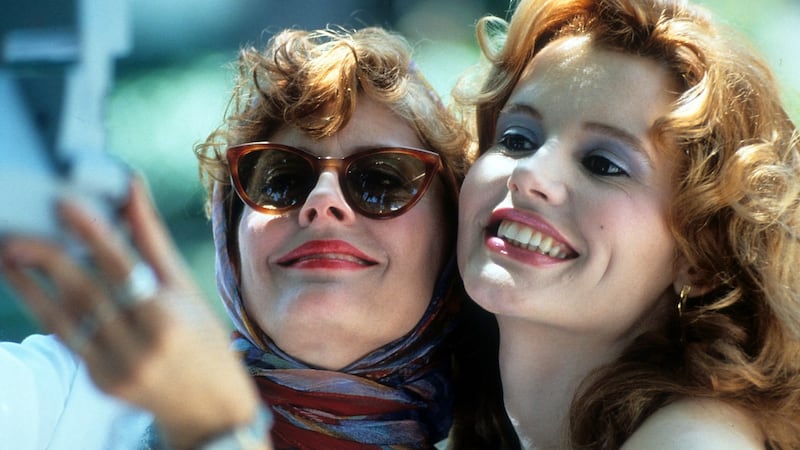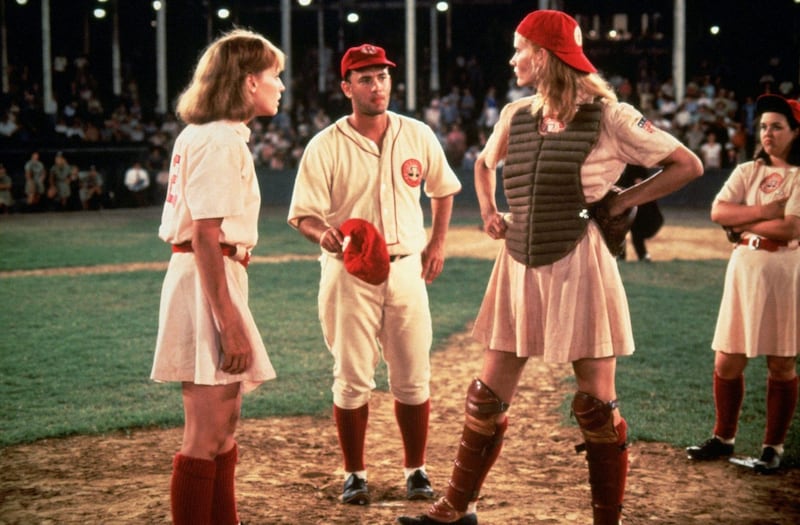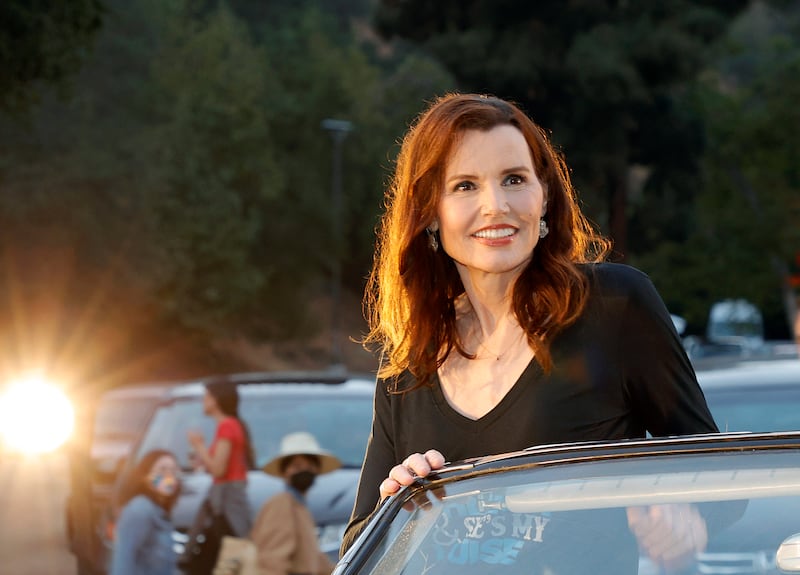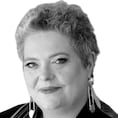Geena Davis is leaning back on a luxurious looking hotel pillow in London drinking tea. We’re on a Zoom call to talk about her memoir, Dying of Politeness, an enjoyable trawl through the life of this movie star, feminist activist, illustrator and data geek. As with the best memoirs, the book is full of surprises. She writes about a late-in-life diagnosis of Attention Deficit Disorder (ADD) and about a foray into archery in her 40s, competing in the Olympic trials for her country. It’s no exaggeration to say there are many strings to this talented woman’s bow.
So lots to talk about then, not least her impressive film career. In the 1980s and 1990s, now 64-year-old Davis starred in a string of commercially successful movies, her first role was alongside Dustin Hoffman in Tootsie, she won a best supporting actress Oscar for playing Muriel Pritchett in Accidental Tourist and performed crowd-pleasing turns in movies such as The Fly, Beetlejuice and A League of Her Own. As a woman of a certain age, I confess to being a little awed by the fact that I am talking to the woman who played Thelma in Thelma & Louise. The 1991 movie she co-starred in with Susan Sarandon was truly groundbreaking and the response from women who saw it – I went to see it three times – was intense.
For those who need a recap, Thelma and Louise were two friends on a weekend fishing road trip who went on the run from police after Louise (Sarandon) shot and killed a man who had tried to rape Thelma. The iconic final scene sees the women choosing to drive their car off a cliff rather than be captured. Despite the dark content, this female-centred buddy movie was exhilarating and uplifting. Davis and Sarandon even made the cover of Time magazine with the headline Why Thelma and Louise Strikes a Nerve. Do women still mention it to her after 30 years?
“When people recognise me from Thelma & Louise, it’s very different from when people recognise me from something like Beetlejuice. There really was a unique reaction to that movie – people have told me it changed their lives – that I very much noticed and paid attention to,” she says.
READ MORE
“At the time it made me realise that women get so few opportunities to really live vicariously through the female characters in movies, while men in almost every movie live vicariously through the male characters. So it registered with me.”
The movie was life-changing for Davis. Not only did it encourage her to start thinking about how her movies would be perceived by female audiences – would it be empowering, would they be inspired? – which changed how she chose future acting roles, but she became friends with Susan Sarandon who helped her with a lifelong struggle.
The title of her memoir, Dying of Politeness, is a reference to her “epically polite” childhood in Massachusetts, New England. “This dangerous politeness was bequeathed to me early on,” she writes. “I was conditioned to think that I mustn’t ask for things, must never put anyone out; so trained to be insanely polite that I learned to have no needs at all.” But in her co-star Sarandon she discovered a woman who had no trouble speaking her mind and was not hated for it.
One obvious example from her book is when Thelma & Louise director Ridley Scott suggested that Davis’s character might sit up on the back seat of the car with her top off. When Davis passed the director’s suggestion on to Sarandon, she went straight up to Scott and told him it wasn’t happening. (As it happens, a young Brad Pitt memorably appears in the movie with his top off. George Clooney and Mark Ruffalo also auditioned for the part of handsome thief JD, but when Davis was asked for her thoughts on who should get the role, bowled over by then unknown Pitt’s charisma and talent, she had no hesitation in saying “the blonde one”.)
I was conditioned to think that I mustn’t ask for things, must never put anyone out; so trained to be insanely polite that I learned to have no needs at all
Sarandon and Davis are still good friends today. “Susan was a revelation to me,” she explains. “Because up until then I hadn’t met a woman or hung out with a woman who was very comfortable in her skin, who said what she thought with great ease. And was just clear-headed and not apologetic for existing, which I was sort of doing up until then. It was my goal to become more like her... she knew what she wanted to say and she would say it and people didn’t freak out, they were still very comfortable around her.”

Another thing that was helpful on her journey towards – as she describes it – full-on “baddassery” was taking powerful roles in movies. “It allowed me to practise being a different type of person, somebody who was bold and takes action and speaks up for themselves. I think it was very helpful.”
Davis first declared aged three that she wanted to become an actress. Her dad was a civil engineer who could turn his hand to anything, and expected the same of his daughter. Her mother was a teaching assistant and politeness queen, but also encouraged that can-do attitude. Growing up Davis – always the tallest person in the room – felt like a misfit because of her height. She was a bundle of contradictions who, on the one hand, struggled with self-esteem, but on the other was convinced she could make it as an actor. She went to Boston University to study drama, later becoming a model in New York and winning the role in Tootsie after her first audition.
I ended up doing it, I didn’t feel like I had a choice but of course I did
Along the way there were challenging moments which she explores in the book, including an incident with actor Bill Murray while auditioning for the 1990 comedy Quick Change. She says Murray tried to use a massage device on her during the audition. “I said no multiple times, but he wouldn’t relent,” Davis writes. “I realised with a profound sadness that I didn’t yet have the ability to withstand this onslaught, or to simply walk out.” Later when the movie was being filmed he went into a rage, shouting at her in full view of cast and crew. Why was it important to write about it all?
[ Geena Davis: ‘I was, like, Hot dog! I’m in something that started change’Opens in new window ]
“It was such a window into my journey,” she says. “I think it wasn’t really about him, it was more about me. I had just won an Oscar and even then I felt like I couldn’t defend myself or stand up for myself.” On the day her book was published, other allegations emerged concerning Murray’s inappropriate behaviour towards a woman on the set of another movie. “So it’s not news to anybody,” she says.
In the book, Davis writes about another audition where the director Rudy De Luca wanted her to act out a scene from the movie with him, sitting on his lap and shoving his face into her breasts. She tried to laugh it off as a joke but he insisted. She writes: “I ended up doing it, I didn’t feel like I had a choice but of course I did. This would be the first in a series of such incidents in my career that made me realise that the mistreatment of female actors was everywhere.” We talk about the #MeToo movement. It must have been satisfying to hear women’s stories finally?

“Oh, yes, yes, absolutely... to have women be believed and then for there to be repercussions with people’s careers ending and people going to jail for the way they treated women, that was fantastic... it’s been an exciting time ever since then. And I think there are some changes that will stick.”
There are six categories of underrepresented groups that we now study including age and ethnicity, LGBTQ people, those with disabilities and people with different body types
She’s been instrumental herself in changing the industry. It’s 18 years since she set up the Geena Davis Institute on Gender in Media, gathering data on female representation on TV and in film. She became a mother in her late 40s to first a daughter and then twin boys. “I wanted to be more evolved before I had children,” she explains. It was while watching TV with her toddler daughter that she began to realise there was a serious issue with the shows they were watching which featured far more male characters than female ones.
“I figured out that the creators of the kids’ entertainment didn’t realise there was a gender disparity, they all said, ‘Oh, no, no, that’s not true any more’. And they would name a movie with one female character as proof that there was gender equality. So I decided, if I get the data, I can go to them directly... I could just go privately and politely to them and share the data. I bet on the fact that the data would make them want to do better. And, it absolutely worked.”
According to her institute’s latest research, there is now gender and race parity on the most popular children’s TV shows. Last year she was given an honorary Oscar for her work in the area.
There is still a lot more work to do, she points out, and she has no intention of stopping. “I can never stop. There are six categories of underrepresented groups that we now study including age and ethnicity, LGBTQ people, those with disabilities and people with different body types. Those groups are much more profoundly underrepresented on screen compared to the real life population.” She is particularly annoyed by the fact that while about 20 per cent of Americans have disabilities, only 1 per cent of movies feature disabled characters. “It’s shameful. So you know, we’re working on all that.”
I’m definitely not interested in ever getting married. I mean, it would just be ridiculous. Or maybe I should really go for it, go for like eight marriages
What does she think about what is happening in her home country around the dismantling of abortion rights and Roe vs Wade? “It’s unfathomable that this is happening,” she says. “That we would take steps back like this. And that a minority of the population is having such an outsized impact, dictating what happens to you and taking away autonomy over your own body is hard to believe. None of us can believe it. It’s just horrific.”
She is also optimistic about the situation and feels the latest developments may galvanise people. “Even conservatives in America, not the rabid ones, the more normal conservatives, are appalled by it and I think we might actually pull something off in the midterm elections that are coming up.”
Davis has had four marriages so far including to Jeff Goldblum, her co-star in The Fly. She is single now. Would she like to get married again? “I’m definitely not interested in ever getting married. I mean, it would just be ridiculous. Or maybe I should really go for it, go for like eight marriages,” she laughs.
Being diagnosed in her 40s with ADD, she says, was “very impactful”. “I thought there was something terribly wrong with me that I should be embarrassed about,” she says of her short attention span. And I didn’t want anybody to know, you know, that I had a character flaw... so it was a huge relief to find out that it was something that didn’t have to do with me being a failure, you know?” She talks about the “superpower” aspects of her condition. “It can be hard to focus but when you do focus, it’s like, the gears mesh, and you really can hyper focus and do it all day and all night. If I start doing something that I really am engaged in, I don’t know when to stop, I don’t know when to go to bed.”

A high achiever all her life and a member of Mensa, her goal now is to keep crunching those numbers about representation in her industry and to continue acting. “I just want to keep getting good roles... I’ve got some very interesting irons in the fire.” She tells me she’s just finished working on Zoe Kravitz’s directorial debut. What’s it called? “Pussy Island,” she says with a huge smile. Kravitz has explained that the movie was “born out of a lack of anger and frustration around the lack of conversation about the treatment of women, specifically in industries that have a lot of money in them, like Hollywood, the tech world, all of that”.
It sounds like the perfect project for Davis. “Pussy Island,” she marvels again. “I was like, ‘are you going to put that on the posters?’ And I think they are.”
Dying of Politeness by Geena Davis is published by HarperCollins





















